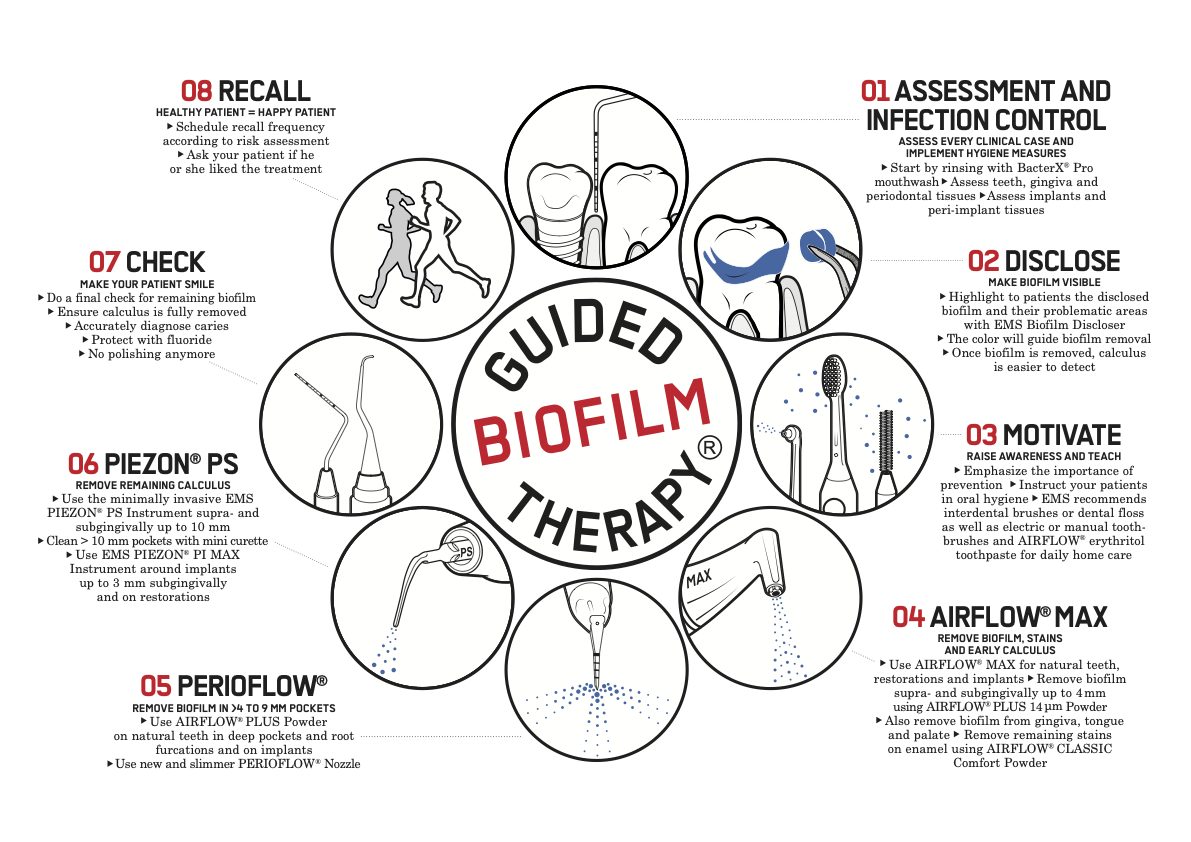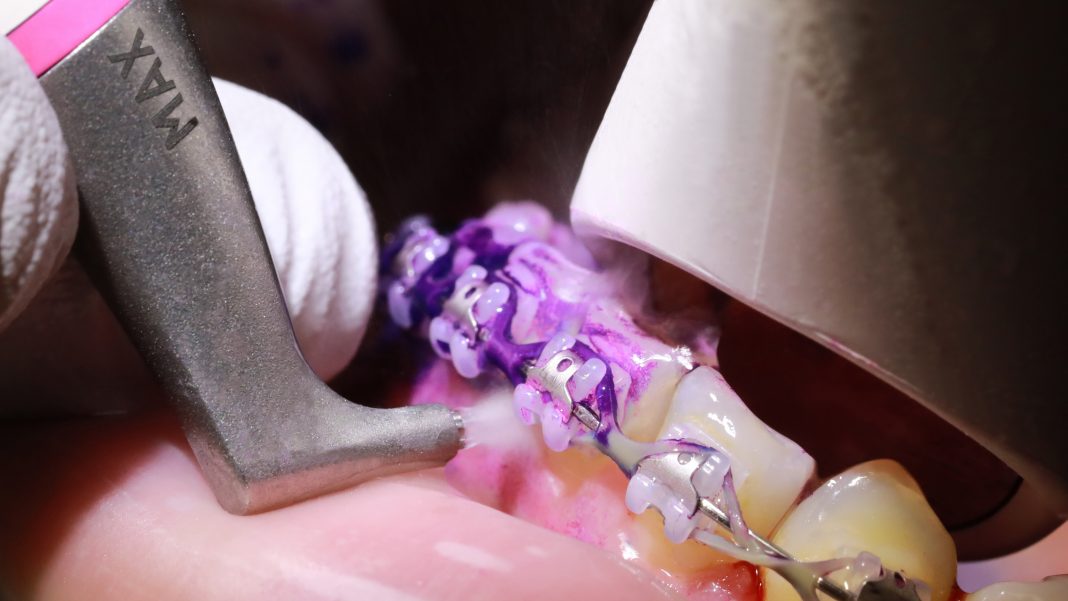Professional teeth cleaning is essential for maintaining oral hygiene and reducing risk of caries, any tooth decay, periodontal or peri-implant disease
Who doesn’t care about their health? But do you know that systemic health is related to oral health? In fact, the mouth is the gateway for external attacks by bacteria and viruses entering the body. Poor oral hygiene is typically characterized by signs of redness of the gingiva, bleeding gums, pain, caries, etc. subjecting the body to multiple systemic risks.
To boost the health of the oral cavity, it is strongly recommended that we perform regular oral hygiene, which includes professional teeth cleaning. Dental prevention combines daily home care and regular professional teeth cleaning. The main objective is to keep the oral cavity healthy and reduce the risk of caries, any tooth decay or periodontal or peri-implant disease.
The root cause comes from bacteria, which protect themselves within a biofilm structure. Managing this biofilm is therefore the biggest challenge today. On a professional level, many treatments are available; however, which ones are the most successful to deliver long-term oral health and what characteristics are important, e.g., minimally invasive, and maximally preventive while giving the patient and the clinicians the highest level of comfort?
A 2015 study conducted by Germany’s Stiftung Warentest (a consumer advocacy foundation) revealed significant shortcomings in conventional professional teeth cleaning. The old method using brushes, polishing pastes and handheld instruments only removes 50% of biofilm in areas that are difficult to reach (1). This was confirmed by a further publication (2) showing that professional teeth cleaning is not able to prevent oral diseases. Clearly, something was incorrect in the traditional approach.
The main issue is that the clinician knows revealing the biofilm is important but skips it, due to time pressure and not having the right technology and training. One of the keys in biofilm management is disclosing! If the biofilm is not disclosed, clinicians only assume biofilm has been removed as it is barely visible to the naked eye.
Modern oral prevention and prophylaxis
Based on the observation of Stiftung Warentest, in 2016 a panel of academicians and practising clinicians, together with EMS, decided to update and renew the old-fashioned approach and introduce the Guided Biofilm Therapy (GBT) protocol. This was supported by innovations in gentle oral prevention such as the original PIEZON NO PAIN® and AIRFLOW® technologies that EMS Electro Medical Systems SA has developed and promoted since the company was founded in 1981.

Guided Biofilm Therapy (GBT)
The Guided Biofilm Therapy protocol is part of a comprehensive preventive concept that aims not only to preserve patients’ oral health but also to improve patient compliance. In eight steps, patients are diagnosed, motivated by disclosing, and treated pain-free by using state-of-the-art technologies.
Furthermore, the Swiss Dental Academy (SDA) was put in place to train professionals to offer GBT prophylaxis at the highest level to patients. The aim of this protocol is to be minimally invasive, preserve hard and soft tissue, and meet patient and clinicians’ expectations. The protocol has been proven to be highly efficient, safe, and comfortable, not only for the patient but also for the clinician.
The GBT Compass and its 8-step protocol guiding the clinicians:
- Assessment and infection control:
- Without assessment there is no diagnosis, so it is mandatory to know the soft tissue condition of the patient including past and present health status.
- Disclose:
- This is the key to achieving prophylaxis treatment on a high level (3). It will reveal the oral biofilm and provide treatment guidance to achieve minimal invasiveness and deliver quality for patients as well as for clinicians.
- Motivate:
- This part is also key to good prophylaxis: obtain patient compliance with home care measures. In fact, successful prophylaxis is the result of teamwork between the dental professional who performs thorough and professional teeth cleaning on a regular base and the patient who maintains good oral hygiene daily.
- AIRFLOW® MAX
- The secret of the GBT treatment. The patented laminar powder jet of the AIRFLOW® MAX cleans gently, quickly and thoroughly the disclosed biofilm supra- and subgingival up to 4mm. To benefit from the most comfortable treatment, only the erythritol-based AIRFLOW® PLUS Powder, size 14 μm, is recommended.
- PERIOFLOW®:
- Designed to clean deep periodontal pockets. For successful treatment outcomes, it is very important to also clean subgingival biofilm in deep pockets systematically. This step is not needed if the patient does not have deep periodontal pockets.
- PIEZON® PS:
- It aims to remove hard calculus also commonly known as tartar, which is made evident after the AIRFLOW® MAX treatment. The usage of fine ultrasonic instruments along with precise and highly specialized controls helps patients appreciate the highest level of comfort throughout the entire dental prophylaxis
- CHECK:
- At the end of the treatment, GBT recommends that every patient is thoroughly checked for any remaining biofilm, calculus and stains. Now caries can be accurately diagnosed.
- RECALL:
- As mentioned previously, biofilm continues to grow constantly; therefore, regular professional cleaning and daily home care are required. The recall interval essentially depends on the patient’s individual clinical situation and is determined based on the risk assessment by the clinician.
References
- Stiftung Wahrentest, test 7/2015 “Professionelle Zahnreinigung”, Gesundheit, p86-89
- Lamont T et al. “Routine scale and polish for periodontal health in adults”. Cochrane Database of Systematic Reviews 2018, Issue 12. Art. No.: CD004625
- Mensi M et al “Plaque disclosing agent as a guide for professional biofilm removal: A randomized controlled clinical trial” Int J Dent Hyg. 2020 Aug;18(3):285-294
Authors
Dr. Neha Dixit
Dr. Marcel Donnet

This work is licensed under Creative Commons Attribution-NonCommercial-NoDerivatives 4.0 International.


